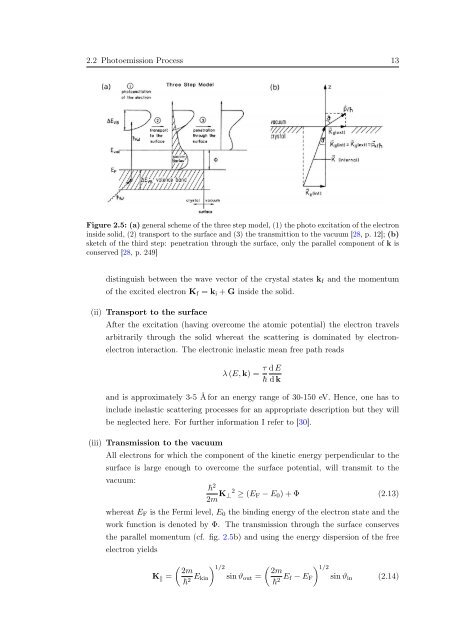Diploma - Max Planck Institute for Solid State Research
Diploma - Max Planck Institute for Solid State Research
Diploma - Max Planck Institute for Solid State Research
You also want an ePaper? Increase the reach of your titles
YUMPU automatically turns print PDFs into web optimized ePapers that Google loves.
2.2 Photoemission Process 13<br />
Figure 2.5: (a) general scheme of the three step model, (1) the photo excitation of the electron<br />
inside solid, (2) transport to the surface and (3) the transmittion to the vacuum [28, p. 12]; (b)<br />
sketch of the third step: penetration through the surface, only the parallel component of k is<br />
conserved [28, p. 249]<br />
distinguish between the wave vector of the crystal states k f and the momentum<br />
of the excited electron K f = k i + G inside the solid.<br />
(ii) Transport to the surface<br />
After the excitation (having overcome the atomic potential) the electron travels<br />
arbitrarily through the solid whereat the scattering is dominated by electronelectron<br />
interaction. The electronic inelastic mean free path reads<br />
λ (E, k) = τ d E<br />
d k<br />
and is approximately 3-5 Å <strong>for</strong> an energy range of 30-150 eV. Hence, one has to<br />
include inelastic scattering processes <strong>for</strong> an appropriate description but they will<br />
be neglected here. For further in<strong>for</strong>mation I refer to [30].<br />
(iii) Transmission to the vacuum<br />
All electrons <strong>for</strong> which the component of the kinetic energy perpendicular to the<br />
surface is large enough to overcome the surface potential, will transmit to the<br />
vacuum:<br />
2<br />
2m K ⊥ 2 ≥ (E F − E 0 ) + Φ (2.13)<br />
whereat E F is the Fermi level, E 0 the binding energy of the electron state and the<br />
work function is denoted by Φ. The transmission through the surface conserves<br />
the parallel momentum (cf. fig. 2.5b) and using the energy dispersion of the free<br />
electron yields<br />
K ‖ =<br />
( 2m<br />
2 E kin<br />
) 1/2<br />
sin ϑ out =<br />
( 2m<br />
2 E f − E F<br />
) 1/2<br />
sin ϑ in (2.14)
















